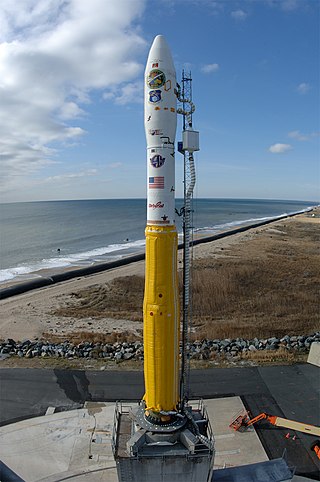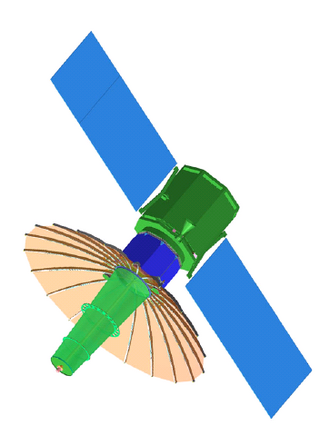Related Research Articles
Orbital Sciences Corporation was an American company specializing in the design, manufacture, and launch of small- and medium- class space and launch vehicle systems for commercial, military and other government customers. In 2014, Orbital merged with Alliant Techsystems to create a new company called Orbital ATK, Inc., which in turn was purchased by Northrop Grumman in 2018. The remnants of the former Orbital Sciences Corporation became a subsidiary of Northrop Grumman, known as Northrop Grumman Space Systems.

The Minotaur is a family of United States solid fuel launch vehicles derived from converted Minuteman and Peacekeeper intercontinental ballistic missiles (ICBM). They are built by Northrop Grumman via contract with the Air Force Space and Missile Systems Center's Space Development and Test Directorate (SMC/SD) as part of the Air Force's Rocket Systems Launch Program which converts retired Intercontinental Ballistic Missiles into space and test launch systems for U.S. government agencies.

FalconSAT is the United States Air Force Academy's (USAFA) small satellite engineering program. Satellites are designed, built, tested, and operated by Academy cadets. The project is administered by the USAFA Space Systems Research Center under the direction of the Department of Astronautics. Most of the cadets who work on the project are pursuing a bachelor of science degree in astronautical engineering, although students from other disciplines join the project.

The Minotaur I, or just Minotaur is an American expendable launch system derived from the Minuteman II missile. It is used to launch small satellites for the US Government, and is a member of the Minotaur family of rockets produced by Orbital Sciences Corporation.
The Space Test Program (STP) is the primary provider of spaceflight for the United States Department of Defense (DoD) space science and technology community. STP is managed by a group within the Advanced Systems and Development Directorate, a directorate of the Space and Missile Systems Center of the United States Space Force. STP provides spaceflight via the International Space Station (ISS), piggybacks, secondary payloads and dedicated launch services.

TacSat-1 was an experimental satellite built by the Naval Research Laboratory (NRL) on behalf of the United States Department of Defense (DoD) Office of Force Transformation (OFT). It was the planned payload of the sixth launch of the SpaceX Falcon 1. It was however never launched into space. The second satellite in the series, TacSat-2, launched before TacSat-1 and this led to the cancellation of TacSat-1's launch.

TacSat-3 is the second in a series of U.S. military experimental technology and communication satellites. It was assembled in an Air Force Research Laboratory (AFRL) Space Vehicles Directorate facility at Kirtland Air Force Base, New Mexico. The TacSat satellites are all designed to demonstrate the ability to provide real-time data collected from space to combatant commanders in the field.
Trailblazer was a technology demonstration satellite, which was to have been operated by the United States Air Force and the Missile Defense Agency. It was selected for launch under a "Jumpstart" contract, to demonstrate responsiveness, with the final payload being chosen less than a month ahead of the scheduled launch date, and was launched as the primary payload of the third Falcon 1, which failed just over two minutes after launch on 3 August 2008. Two previous Falcon 1 launches also failed to reach orbit, but the fourth succeeded although it only carried a dummy payload.

NanoSail-D was a small satellite which was to have been used by NASA's Ames Research Center to study the deployment of a solar sail in space. It was a three-unit CubeSat measuring 30 cm × 10 cm × 10 cm, with a mass of 4 kg (8.8 lb). The satellite was lost shortly after launch due to a problem with the launch vehicle carrying it; however, a replacement, NanoSail-D2, was launched in 2010 to complete its mission.
The Space Based Space Surveillance (SBSS) system is a planned United States Space Force constellation of satellites and supporting ground infrastructure that will improve the ability of the United States Department of Defense (DoD) to detect and track space objects in orbit around the Earth.

Minotaur IV, also known as Peacekeeper SLV and OSP-2 PK is an active expendable launch system derived from the LGM-118 Peacekeeper ICBM. It is operated by Northrop Grumman Space Systems, and made its maiden flight on 22 April 2010, carrying the HTV-2a Hypersonic Test Vehicle. The first orbital launch occurred on 26 September 2010 with the SBSS satellite for the United States Air Force.

TacSat-4 is the third in a series of U.S. military experimental technology and communication satellites. The United States Naval Research Laboratory (NRL) is the program manager. The Office of Naval Research (ONR) sponsored the development of the payload and funded the first year of operations. The Office of the Director of Defense Research and Engineering (DDR&E) funded the standardized spacecraft bus and the Operationally Responsive Space Office (ORS) funded the launch that will be performed by the Air Force's Space and Missile Systems Center (SMC).

During the second half of 2002, the Naval Research Laboratory studied the tactical application of space assets. Relatively new technologies and processes in the areas of microsatellites, affordable and quick-response launch vehicles, and the classified SIPRNet made tactical use of space assets possible in the relatively near term. The DoD's Office of Force Transformation (OFT) agreed with the core findings of the study and decided to start an Operationally Responsive Space (ORS) Initiative consisting of a series of experiments. TacSat-1 is the first experiment in this OFT initiative. The TacSat-1 experiment received go-ahead on 7 May 2003.

The Space Launch Complex 46 (SLC-46), previously Launch Complex 46 (LC-46), is a launch complex at Cape Canaveral Space Force Station operated under license by Space Florida previously used for Athena rocket launches. It has been used by Astra, which will continue the use with Rocket 4 and maybe 5 and will be used by ABL Space Systems for the near-term use by RS1.

USA-231, or ORS-1 is an American reconnaissance satellite which was launched in 2011 from NASA’s Wallops Flight Facility, Virginia by a Minotaur I launch vehicle. It is the first operational satellite of the Operationally Responsive Space Office. It is equipped with a SYERS 2A sensor.

SPARK, or Spaceborne Payload Assist Rocket - Kauai, also known as Super Strypi, is an American expendable launch system developed by the University of Hawaii, Sandia and Aerojet Rocketdyne. Designed to place miniaturized satellites into low Earth and Sun-synchronous orbits, it is a derivative of the Strypi rocket which was developed in the 1960s in support of nuclear weapons testing. SPARK is being developed under the Low Earth Orbiting Nanosatellite Integrated Defense Autonomous System (LEONIDAS) program, funded by the Operationally Responsive Space Office of the United States Department of Defense.
Sapphire is a Canadian space surveillance satellite which was launched in 2013. Sapphire was commissioned and integrated by MacDonald, Dettwiler and Associates (MDA) based on an SSTL-150 bus produced by Surrey Satellite Technology (SSTL) and an optical payload produced by COM DEV International.

PhoneSat is an ongoing NASA project of building nanosatellites using unmodified consumer-grade off-the-shelf smartphones and Arduino platform and launching them into Low Earth Orbit. This project is part of NASA's Small Spacecraft Technology Program and was started in 2009 at NASA Ames Research Center.

Lunar IceCube is a NASA nanosatellite orbiter mission that was intended to prospect, locate, and estimate amount and composition of water ice deposits on the Moon for future exploitation. It was launched as a secondary payload mission on Artemis 1, the first flight of the Space Launch System (SLS), on 16 November 2022. As of February 2023 it is unknown whether NASA team has contact with satellite or not.
TacSat-6 is a U.S. military experimental technology and communication satellite. The Operationally Responsive Space Office (ORS) funded the launch that was performed by the United States Army Space and Missile Defense Command (SMDC).
References
- 1 2 Rupp, Sheila. "Operationally Responsive Space". USAF. Archived from the original on 2016-03-03. Retrieved 2015-10-23.
- ↑ "ORS: Operationally Responsive Space - Leadership". Ors.csd.disa.mil. Archived from the original on 2013-02-14. Retrieved 2015-10-23.
- ↑ "SpaceDev Satellite Chosen for Inaugural U.S. Defense ORS Jumpstart Mission". SpaceDev. Retrieved 2015-10-23.
- ↑ Graham, William (2011-06-29). "Orbital Minotaur I launches with ORS-1 following eventful count". NASASpaceFlight.com. Retrieved 2015-10-23.
- ↑ "Public Affairs Office - U.S. Naval Research Laboratory". Nrl.navy.mil. 2011-12-12. Archived from the original on 2010-06-20. Retrieved 2015-10-23.
- ↑ Clark, Stephen (30 October 2015). "Inaugural launch of small-class rocket on hold in Hawaii". Spaceflight Now. Retrieved 30 October 2015.
- ↑ Clark, Stephen. "Air Force declares failure on Super Strypi test launch". Spaceflight Now. Retrieved 4 November 2015.
- ↑ "Operationally Responsive Space–4 "Super Strypi – Responsive Small Launch" Mission Description" (PDF). ors.csd.disa.mil. Archived from the original (PDF) on 2014-12-10. Retrieved 2014-11-03.
- ↑ "Converted Missile Launches Military Satellite to Track Spacecraft and Debris". Space.com . 2017-08-26. Archived from the original on 2023-04-30.